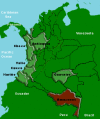Genetic Characterisation of Plasmodium falciparum Isolates with Deletion of the pfhrp2 and/or pfhrp3 Genes in Colombia: The Amazon Region, a Challenge for Malaria Diagnosis and Control
- PMID: 27636709
- PMCID: PMC5026348
- DOI: 10.1371/journal.pone.0163137
Genetic Characterisation of Plasmodium falciparum Isolates with Deletion of the pfhrp2 and/or pfhrp3 Genes in Colombia: The Amazon Region, a Challenge for Malaria Diagnosis and Control
Abstract
Most Plasmodium falciparum-detecting rapid diagnostic tests (RDTs) target histidine-rich protein 2 (PfHRP2). However, P. falciparum isolates with deletion of the pfhrp2 gene and its homolog gene, pfhrp3, have been detected. We carried out an extensive investigation on 365 P. falciparum dried blood samples collected from seven P. falciparum endemic sites in Colombia between 2003 and 2012 to genetically characterise and geographically map pfhrp2- and/or pfhrp3-negative P. falciparum parasites in the country. We found a high proportion of pfhrp2-negative parasites only in Amazonas (15/39; 38.5%), and these parasites were also pfhrp3-negative. These parasites were collected between 2008 and 2009 in Amazonas, while pfhrp3-negative parasites (157/365, 43%) were found in all the sites and from each of the sample collection years evaluated (2003 to 2012). We also found that all pfhrp2- and/or pfhrp3-negative parasites were also negative for one or both flanking genes. Six sub-population clusters were established with 93.3% (14/15) of the pfhrp2-negative parasites grouped in the same cluster and sharing the same haplotype. This haplotype corresponded with the genetic lineage BV1, a multidrug resistant strain that caused two outbreaks reported in Peru between 2010 and 2013. We found this BV1 lineage in the Colombian Amazon as early as 2006. Two new clonal lineages were identified in these parasites from Colombia: the genetic lineages EV1 and F. PfHRP2 sequence analysis revealed high genetic diversity at the amino acid level, with 17 unique sequences identified among 53 PfHRP2 sequences analysed. The use of PfHRP2-based RDTs is not recommended in Amazonas because of the high proportion of parasites with pfhrp2 deletion (38.5%), and implementation of new strategies for malaria diagnosis and control in Amazonas must be prioritised. Moreover, studies to monitor and genetically characterise pfhrp2-negative P. falciparum parasites in the Americas are warranted, given the extensive human migration occurring in the region.
Conflict of interest statement
The authors have declared that no competing interests exist.
Figures



Similar articles
-
Deletion of Plasmodium falciparum Histidine-Rich Protein 2 (pfhrp2) and Histidine-Rich Protein 3 (pfhrp3) Genes in Colombian Parasites.PLoS One. 2015 Jul 7;10(7):e0131576. doi: 10.1371/journal.pone.0131576. eCollection 2015. PLoS One. 2015. PMID: 26151448 Free PMC article.
-
Geographical distribution and genetic characterization of pfhrp2 negative Plasmodium falciparum parasites in the Peruvian Amazon.PLoS One. 2022 Nov 22;17(11):e0273872. doi: 10.1371/journal.pone.0273872. eCollection 2022. PLoS One. 2022. PMID: 36413547 Free PMC article.
-
Prevalence of pfhrp2 and pfhrp3 gene deletions in Puerto Lempira, Honduras.Malar J. 2015 Jan 21;14:19. doi: 10.1186/s12936-014-0537-7. Malar J. 2015. PMID: 25604310 Free PMC article.
-
Genetic diversity and deletion of Plasmodium falciparum histidine-rich protein 2 and 3: a threat to diagnosis of P. falciparum malaria.Clin Microbiol Infect. 2019 May;25(5):580-585. doi: 10.1016/j.cmi.2018.09.009. Epub 2018 Sep 27. Clin Microbiol Infect. 2019. PMID: 30267926 Review.
-
Force Protection Risks in AFRICOM, INDOPACOM and SOUTHCOM Due to Rapid Diagnostic Test Failures for Falciparum Malaria, 2016-2022.MSMR. 2023 Oct 1;30(10):7-11. MSMR. 2023. PMID: 37963222 Review.
Cited by
-
A novel multiplex qPCR assay for detection of Plasmodium falciparum with histidine-rich protein 2 and 3 (pfhrp2 and pfhrp3) deletions in polyclonal infections.EBioMedicine. 2020 May;55:102757. doi: 10.1016/j.ebiom.2020.102757. Epub 2020 May 8. EBioMedicine. 2020. PMID: 32403083 Free PMC article.
-
Impact of Plasmodium falciparum pfhrp2 and pfhrp3 gene deletions on malaria control worldwide: a systematic review and meta-analysis.Malar J. 2021 Jun 22;20(1):276. doi: 10.1186/s12936-021-03812-0. Malar J. 2021. PMID: 34158065 Free PMC article.
-
A Comprehensive Analysis of the Genetic Diversity of Plasmodium falciparum Histidine-Rich Protein 2 (PfHRP2) in the Brazilian Amazon.Front Cell Infect Microbiol. 2021 Sep 21;11:742681. doi: 10.3389/fcimb.2021.742681. eCollection 2021. Front Cell Infect Microbiol. 2021. PMID: 34621693 Free PMC article.
-
Diverse origin of Plasmodium falciparum in northwest Ecuador.Malar J. 2019 Jul 26;18(1):251. doi: 10.1186/s12936-019-2891-y. Malar J. 2019. PMID: 31349843 Free PMC article.
-
Assessing the histidine-rich protein 2/3 gene deletion in Plasmodium falciparum isolates from Burkina Faso.Malar J. 2023 Nov 29;22(1):363. doi: 10.1186/s12936-023-04796-9. Malar J. 2023. PMID: 38017455 Free PMC article.
References
-
- World malaria report 2015. World Health Organization, Geneva, Switzerland; 2015.
-
- Boletín Epidemiologico No. 49 de la Malaria en Colombia. Instituto Nacional de Salud. Bogotá, Colombia; 2015. Available: http://www.ins.gov.co/boletin-epidemiologico/Boletn%20Epidemiolgico/2015...
-
- Wongsrichanalai C, Barcus MJ, Muth S, Sutamihardja A, Wernsdorfer WH. A review of malaria diagnostic tools: microscopy and rapid diagnostic test (RDT). Am J Trop Med Hyg. 2007;77: 119–127. - PubMed
-
- WHO-WPRO website. Malaria Rapid Diagnostic Tests: A total list of ISO:13485 certified manufacturers and their RDT products. Available: http://www2.wpro.who.int/sites/rdt/documents/
MeSH terms
Substances
Grants and funding
LinkOut - more resources
Full Text Sources
Other Literature Sources

